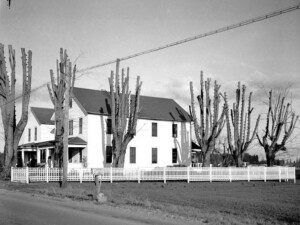Marion County Poor Farm

Ben Maxwell, 1941, Pictured is the Marion County Poor Farm in 1941. The purpose of the County Poor Farm was indigent relief. The Salem City Directory for 1940 lists the location as 2770 Front Street North. The telephone directory for the early 1940’s as Route 2 (North River Road?). It was administered by the Marion County Health Department. Object ID 9092 shows that the trees along one side have been pruned and not in object ID 9094. A white picket fence runs along the side where the trees are growing. It is a large two story building with two separate entrances. More buildings can be seen behind the front structure., Salem Public Library 9092
Prior to the establishment of the Marion County Poor Farm, the Marion County Commissioners were authorized to appoint someone in the community to care for those labeled by the government as “indigent citizens” – being unable to pay their own expenses because of age or health issues – at county expense.
An example appears in the Commissioners Court Journal for the December 1856 term: Bluford Smith was appointed to provide for Cyrus Pitney, who “was sick and unable to earn a livelihood in Consequence of bodily infirmity…” Often the people chosen to care for these individuals were doctors or owners of boarding houses. A contract between Dr. G. W. Brown and the county in October 1866 stipulates that the doctor would take in any county charges for $4.00 per week.
That same year of 1866, an editorial in the Oregon Statesman called for the establishment of a County Infirmary to care for “the aged and infirm, who are thrown upon the charities of the world…”
By May of 1870 a Poor Farm Account had been set up in the Commissioners Court and a farm purchased near Silverton for the housing and care of the poor “…for the sum of four dollars per week for all classes of Paupers, in whatever condition they may be…”
This experiment with putting county charges to work on the farm apparently failed. Seven years later property was bought in North Salem at 2770 Front Street and a double house of two stories was built. The left wing housed the superintendent and his family while the right wing furnished private rooms for up to fifteen inmates. Thirty-three acres around the home provided room for an orchard and garden with some ten acres of timberland left over.
Documents from this time indicate in this facility, “The County pays $2.50 per week for their board and care, but their clothes and medical attention are extra.” As most of the inmates were either terminally ill at their entry into the home or were suffering extreme old age, the cost of medical care and of funeral expenses was significant.
A cemetery was established on the grounds early in 1898 (called either Terrell or County Farm Cemetery) receiving at least twenty-five burials from that year until 1942 when the Poor Farm was closed.
As early as 1889 comments from the local newspaper remarked that the Poor Farm was becoming a drain on county finances and a cost to taxpayers for supporting “the county poor.”
Apparently these sentiments were addressed by the County Commissioners and steps were taken to decide the fate of the county’s Poor House. Whether the decision would be to sell the present site in order to secure a larger one and make the home self-sustaining or to close it altogether occupied the next two years.
Several properties in and around Salem were considered (including that which would later become the Reform School) but no change was made. Ultimately the county determined that to continue operation of the Poor Farm was a needless expense and the farm was abandoned.
It was decided that those inmates still living at the house could be supported “through old age relief, general assistance, or other funds.” The property was leased to Mr. and Mrs. Lloyd Hill, last managers of the Poor Farm.
Article written by Sue Bell on the original Salem Online History. Language was reviewed and updated in 2022.
Bibliography:
Marion County Commissioners Court Journal Vol. II, p. 243; Vol. III, p. 561.Vol. V, pp. 69, 70; Vol. XXXIV, p. 723.
First Biennial Report of the State Board of Charities and Corrections 1892, pp. 120-123.
Weekly Oregon Statesman 15 May 1885, p. 6.
Susan N. Bell, “Marion County Poor Farm and Cemetery,” Beaver Briefs, Vol. 31, #2 (Spring 1999), pp. 1-20.
Oregon Statesman 13 Aug. 1866, p. 3;18 & 19 May 1889, p. 4; 8 June 1889, p. 4.; 19 May 1889, p. 4.; 4 Apr. 1942, p. 4.
Photo:
Record number: 9092
Photographer: Ben Maxwell
Copyright: Salem Public Library







Leave A Comment